-
1 of 253523 objects
Vases mounted in gilt bronze vases: c.1690-1720, mounts: 1725-50
Porcelain painted in underglaze blue, overglaze enamel colours and gold, mounted in gilt bronze | 34.9 x 28 x 20.5 cm (whole object) | RCIN 12
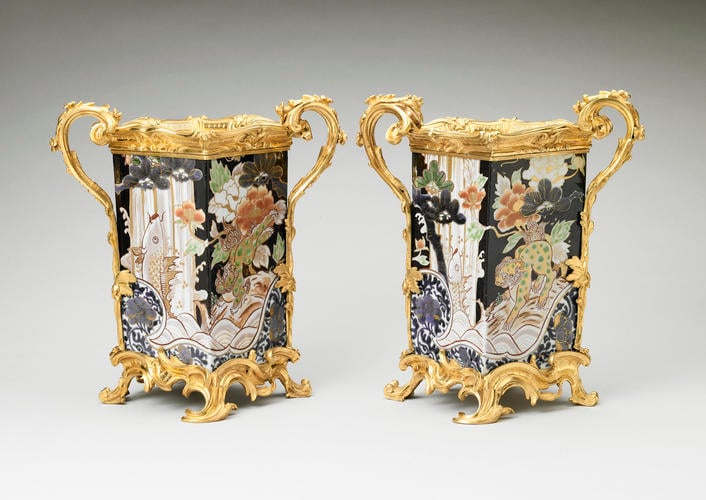

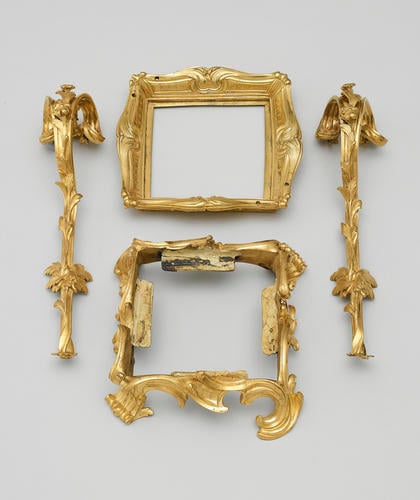
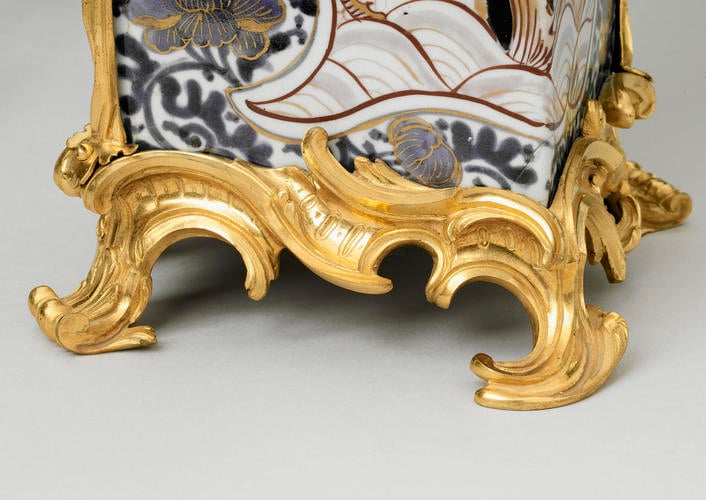
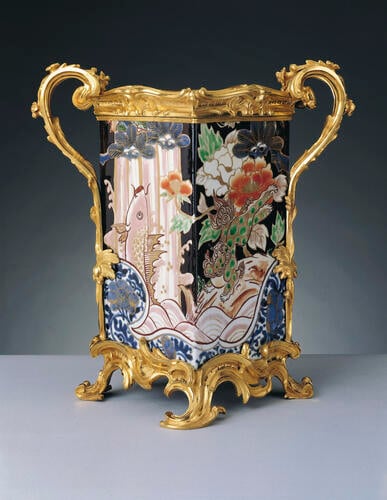
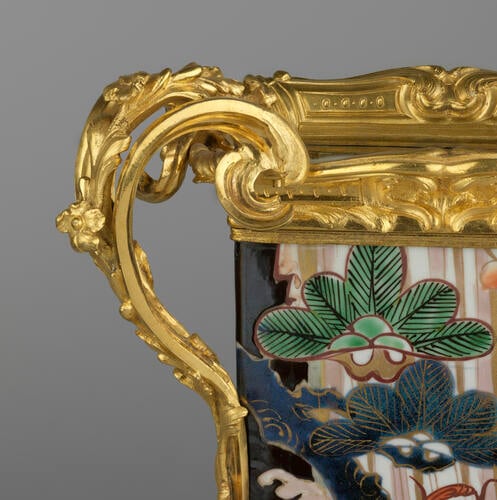
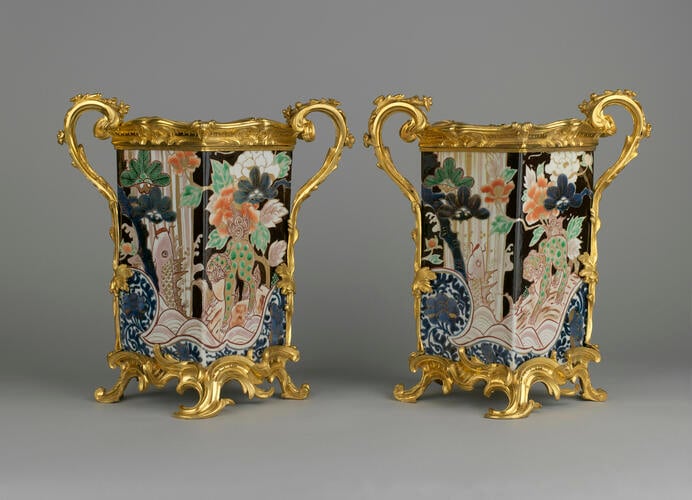
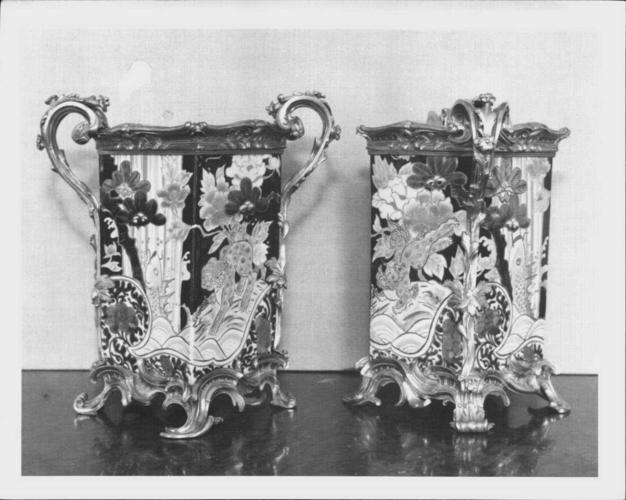
-
Chinese tradition tells of carp (koi) attempting to swim upstream at the Dragon Gate rapids, impeded by demons who increased the height of the waterfall. After considerable struggle, the carp which succeeded were turned into golden dragons. The fish consequently became an emblem of perseverance and success. The scene on these vases evokes the legend, and may be related to a samurai’s coming-of-age ceremony (genpuku) or Boys’ Day (5 May) when carp streamers called koinobori are flown on poles. In Japan, koi are particularly associated with the steadfastness and determination of the samurai.
Square porcelain flasks of similar form to those with Kakiemon style decoration (RCIN 2337.1-2), cut down below the shoulder. Painted across two faces, with a carp ascending a waterfall and a green-spotted and gilt kirin by a peony plant on the bank, all on a rare black-enamelled ground framed by flower scrolls in blue within curving borders, with the design repeated on the other two sides. The square top edge is enclosed by an everted rim formed of panels with stylised fluting on each side, the upper edges with confronting foliate scrolls terminating in a C-scroll cartouche, the outside cartouches with a pounced ground; two opposing corners fitted with scrolled bifurcated handles, divided by a foliate branch reaching to a richly scrolled rockwork base, with an outscrolled foot below each handle and a C-scroll foot on the remaining opposing corners; the underside of the foot of RCIN 12.1 vase is notched ‘I’, and RCIN 12.2 is notched ‘II’.
This form of container was based on European, especially Dutch, pottery or glass spirit flasks, and was made in large numbers for export from Japan from the end of the seventeenth century. The Silberkammer in the Hofburg, Vienna, contains identical vases with similar mounts, as well as matching, taller flasks which have not been cut down. The decoration of these examples is rarer on Japanese porcelain than Chinese (the so-called famille noire style). The French gilt bronze mounts have been designed with some care in relation to the very colourful and asymmetric decoration of the vases. Thus the short 'C'- scrolls of the foot mounts respect the curving border lines of the painted scenes, and the painted flowers seem to sprout from the gilt bronze stems which run up the handles. Similar mounts occur on a pair of Yixing red stoneware canisters at the Petit Palais, Paris.
These vases are probably the pair described in the Library at the Royal Pavilion, Brighton, in 1829. Interestingly, they were displayed alongside black lacquer pieces in this room, perhaps because of their complementary rare black enamel ground.
Text adapted from Royal Treasures, A Golden Jubilee Celebration, London 2002, Chinese and Japanese Works of Art in the Collection of Her Majesty The Queen: Volume II and Japan: Courts and Culture (2020)Provenance
Probably acquired by George IV. Referred to in the Library, Brighton Pavilion, ‘A pair of square Japan China Jars with Fish, Flowers, & Kylins, & green enamelled leaves, mounted diamond shape in rich ormolu top & bottom scroll & leaf borders & handles -, twelve inches...’ (internal reference 1829B, p. 60); described in His Majesty’s Old Dressing Room ‘from Library’ (internal reference 1829B, at the back, p. 36); March 1847 sent to Buckingham Palace (internal referenece 1829A, p. 32), noted in the East Wing.
-
Creator(s)
(nationality)(metalworker)Acquirer(s)
-
Medium and techniques
Porcelain painted in underglaze blue, overglaze enamel colours and gold, mounted in gilt bronze
Measurements
34.9 x 28 x 20.5 cm (whole object)
Other number(s)
Place of Production
Arita [Saga]